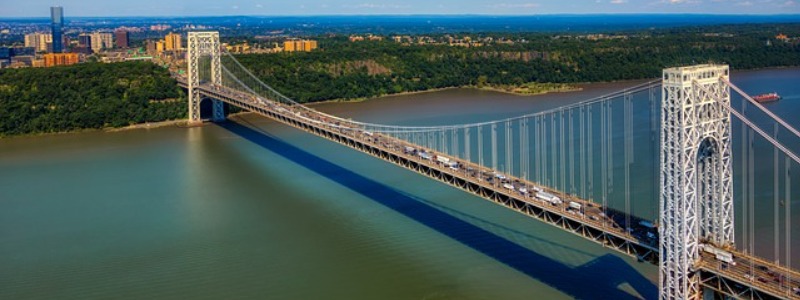Connecting New York City with New Jersey, the George Washington Bridge handles more traffic than any other bridge in the world. Opened in the 1930s, this engineering marvel carries vehicles over the Hudson River. Featuring massive steel towers at its edges, the busy double-decked suspension bridge has been an iconic symbol of NYC for generations. Click to book your New York Helicopter Tour: Ultimate Manhattan Sightseeing tour.
Sightseeing
Driving over the George Washington Bridge isn’t the best way to embrace this historic infrastructure. On the Manhattan side, the north and south sidewalks have wide layouts that accommodate pedestrians and bicyclists. On the New Jersey side, two separate entrances/exits are also available to the sidewalks on the bridge. Most points along the sidewalks offer panoramic views of the scenic Palisades Cliff that rise above the western banks of the Hudson River. When standing close to the NJ side of the bridge, you’ll see the iconic skyline of Midtown Manhattan.
If you’d like to admire the George Washington Bridge from ground level with minimal noise, head to Fort Washington Park. Surrounded by dense trees, this beautiful riverfront green space includes the Little Red Lighthouse and American Redoubt Marker. Situated on the NJ side, the Fort Lee Historic Park also offers great views of the bridge and plenty of recreational activities. This park includes a visitor’s center with exhibits that explain the area’s importance during the American Revolution. Both parks have lots of benches, family-friendly amenities, and extensive trails that provide unique perspectives of the iconic bridge.
History
The George Washington Bridge was commissioned in 1927 by the Port Authority of NY and NJ. Specializing in structural engineering, Swiss-American Othmar Ammann was hired for the ambitious project. Cass Gilbert, who designed some of the most magnificent architectural landmarks nationwide, was the main architect of the bridge.
It took approximately four years to complete this double-decked suspension bridge, which was the longest of its kind in the world. In its first year, the bridge accommodated more than 5 million vehicles. In 1962, the Lower Level opened to meet the rapid traffic growth of the NYC metropolitan area. Since then, the George Washington Bridge has been one of the busiest water crossings in the world.
Visiting George Washington Bridge
Carrying more than a dozen lanes, the George Washington Bridge serves as the most important crossing over the Hudson River. Interstate 95 runs along the entire span of this busy bridge. The NJ Turnpike, Palisades Interstate Parkway, and NJ Route 4 are some major roads that intersect I-95 on the NJ side. On the Manhattan side, the bridge merges with the Henry Hudson Parkway, which runs along the entire western flank of the borough. Additionally, I-95 merges with I-87 just a few blocks to the east of the bridge.
Carrying eight lanes, the Upper Level of the George Washington Bridge is open to all types of traffic. However, trucks, RVs, and other large commercial vehicles aren’t allowed on the Lower Level. It’s a good idea to use this deck of the bridge to avoid heavy traffic during rush hour.
Compared to other crossings in the United States, the George Washington Bridge charges some of the highest toll fees. All drivers entering the bridge on the NJ side must pay the charges at the toll plazas. Fortunately, the E-Z Pass system facilitates traffic flow heading eastbound into the bridge. Discounts are available depending on the number of passengers in your vehicle or the type of vehicle. For example, the Port Authority of NY and NJ offers carpooling discounts during specific times of the day.
Location: in New York/New Jersey, crosses over the Hudson River
Click here for more information on George Washington Bridge.

